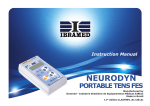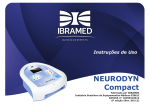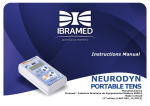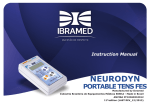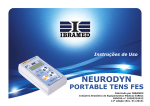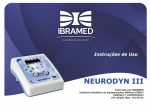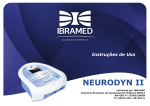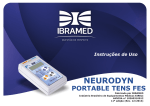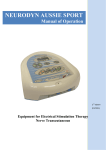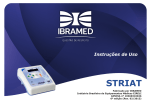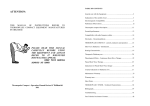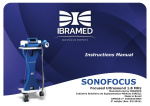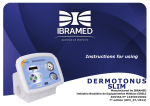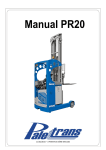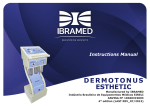Download NEURODYN 10 CHANNELS
Transcript
Instruction Manual NEURODYN 10 CHANNELS Manufactured by Ibramed - Indústria Brasileira de Equipamentos Médicos EIRELI Made in Brazil rd 10 edition (12/2012) Anvisa nº 10360310023 TABLE OF CONTENTS SYMBOL DEFINITIONS.................................................3 CARTON ............................................................4 ABREVIATIONS GLOSSARY...........................................4 FIGURES GLOSSARY....................................................5 FOREWORD................................................................6 PRODUCT DESCRIPTION . ............................................6 SAFETY PRECAUTIONS.................................................7 PRECAUTIONARY DEFINITIONS.............................7 ELECTROTHERAPY INDICATIONS, CONTRAINDICATIONS, PRECAUTIONS AND ADVERSE REACTIONS...........................................9 SPECIFICATIONS.......................................................23 SYSTEM SPECIFICATIONS...................................23 ACCESSORIES USED .........................................26 OPERATING INSTRUCTIONS .......................................27 PROGRAMMING EQUIPMENT ......................................28 ELECTRODE GUIDELINE ............................................30 ELECTROTHERAPY PATIENT PREPARATION...................................................30 ELECTRODE POSITIONING..................................30 USING THE PROG/MENU BUTTON................................34 USING THE MENU BUTTON..................................34 USING THE PROG BUTTON..................................34 CLINICAL RESOURCES LIBRARY - INDICATIONS FOR USE........................................9 CONTRAINDICATIONS..........................................10 WARNINGS.........................................................10 PRECAUTIONS.....................................................10 ADVERSE REACTIONS .........................................11 GENERAL EQUIPMENT CARE..........................................11 SHIPPING DAMAGE..............................................11 INSTALLATION, CARE AND CLEANING.....................11 Electromagnetic Compatibility Guidance.......12 ELETROMAGNECTIC COMPATIBILITY..............................13 NOMENCLATURE..........................................................19 CONTROLS, INDICATORS AND CONNECTIONS....................................................19 SYMBOL DEFINITIONS.................................................20 2 CLINICAL PROTOCOLS...............................................35 REFERENCES............................................................38 ACCESSORIES ACCOMPANYING NEURODYN 10 CHANNELS..........................................51 TROUBLESHOOTING..................................................53 MAINTENANCE, WARRANTY AND TECHNICAL SUPPORT.................................................53 MAINTENANCE..................................................53 WARRANTY.......................................................53 WARRANTY TERMS.............................................54 TECHNICAL ASSISTANCE ...................................55 CEFAI – IBRAMED Center for Education and Advanced Training.................................56 SYMBOL DEFINITIONS BELOW ARE THE DEFINITIONS OF THE SYMBOLS USED ON THE EQUIPMENT AND THROUGHOUT THE INSTRUCTIONS FOUND IN THIS MANUAL. UNDERSTAND THESE SYMBOLS AND THEIR DEFINITIONS BEFORE OPERATING THIS EQUIPMENT. Start treatment. Stop treatment. Caution! Refer to user manual. Off switch. TYPE BF Electrical equipment. On switch. Dangerous voltage. Voltage in AC (Alternating Current). CLASS II Electrical equipment. Electrical Network (Alternating Current). Not protected against the harmful effects of water penetration. Sensitivity against electrostatic discharge. 3 in AC SYMBOL DEFINITIONS ABREVIATIONS GLOSSARY CARTON Fragile. This side up. Limits of temperature for storage and packaging in °C (Celsius Degrees). Keep away from the rain. Stacking up. Do not use if the packaging is damaged. Refer to operating correct product use. instructions for Manufacturer’s name and address. 4 Hz Hertz (pulses per second) kHz Kilohertz mA Milliampere VA Volt Ampere ms Miliseconds kg kilograms Russ Russian Current Rise Time of Increase Gradient On Time of Muscular Contraction Decay Time of Decrease Gradient Off Time of Muscular Relaxation Cont Continuous Sync Synchronous Rec Reciprocal Seq Sequential Des Desobstruction Burst Series of pulses FIGURES GLOSSARY Figure 1. Upper Access Panel......................................19 Figure 2. Rear Access Panel .......................................19 Figure 3. Front Access Panel.......................................19 Figure 4. Lower Access Panel......................................19 Figure 5. NEURODYN 10 CHANNELS LCD..................20 Figure 6. A. Pin cables with banana ends (2 mm) (in the same cable has two channels with individual controls); B. Self-adhesive conductive electrodes. .........26 Figure 7. Pens for facial stimulation with conductive electrodes on the tips ................................................26 Figure 8. Pin cables with banana ends (2 mm) connected to alligator clip adapters to fix the needles to electrolypolisis (in the same cable has two channels with individual controls)..............................................26 Figure 9. A. and B. LCD Messages; C. NEURODYN 10 CHANNELS Electro Stimulator Default Screen................27 Figure 10. Bipolar Electrode Placement Technique...........30 Figure 11. Monopolar Electrode Placement Technique........31 Figure 12. Facial Electrode Placement Technique..............31 Figure 13. A. Electrolypolisis Electrode-Needles Placement Technique..................................................32 Figure 14. Electrode sizes and current density.............33 Figure 15. LCD displays the selected language............34 Figure 16. Selection of Treatment Protocols - Prog 1....34 Figure 17. Parameters of the Pre-Programmed Protocol 1 Program...................................................34 Figure 18. User 01 Protocol......................................35 5 FOREWORD PRODUCT DESCRIPTION This user manual allows the user to efficiently use the NEURODYN NEURODYN 10 CHANNELS Electro Stimulator. It also neuromuscular stimulator is a ten-channel stimulator gives suggestions for treatment protocols so that you with independent controls for current therapies used in: can use your equipment to its full potential. RUSSIAN Consult other resources for additional information Frequency) and AUSSIE CURRENT (Burst Modulated regarding the uses of electrotherapy before attempting Medium Frequency). 10 CURRENT CHANNELS (Burst transcutaneous Modulated Medium any treatment on a patient. Users must read, understand and follow the information in this manual for each Treatment should be administered only under the direct mode of treatment available, as well as the indications, supervision of a health care professional. contraindications, warnings and precautions. The specifications and instructions in this manual are in effect at the time of its publication. These instructions may be updated at any time at the manufacturer’s discretion. Visit our website for updates. 6 SAFETY PRECAUTIONS PRECAUTIONARY DEFINITIONS The precautionary instructions found in this section and throughout this manual are indicated by specific symbols. • Read, understand, and practice the precautionary and Understand these symbols and their definitions before operating instructions. Know the limitations and hazards operating this equipment prior to therapy session. associated with the use of any electrical stimulation. Observe the precautionary and operational labels placed on the unit. Text with a “CAUTION” indicator refers to potential safety • DO NOT operate this unit in an environment where other infractions that could cause minor to moderate injury or devices intentionally radiate electromagnetic energy in damage to equipment. an unshielded manner. • Check cables and associated connectors before each use. Text with a “WARNING” indicator refers to potential • The NEURODYN 10 CHANNELS Electro Stimulator is safety infractions that could cause serious injury and not designed to prevent the infiltration of water or other equipment damage. liquids. The infiltration of water or other liquids could cause malfunction of internal components of the system and therefore create a risk of injury to the patient. • Disconnect the power plug from the outlet when left Text with a “DANGER” indicator refers to potential safety unused for long periods of time. infractions that represent immediately life threatening situations that would result in death or serious injury. 7 SAFETY PRECAUTIONS • Stimulation should not be applied over the anterior neck or mouth. • Severe spasm of the laryngeal and pharyngeal muscles • To protect against the risk of fire, only use replacement may occur and the contractions may be strong enough fuses of the same types and ratings. to close the airway or cause breathing difficulties. • Be sure the unit is grounded by connecting it to a • Stimulation should not be applied transthoracically to grounded electrical outlet compliant with the applicable avoid the introduction of electrical current into the heart national and local electrical codes. which may cause cardiac arrhythmia. • Powered muscle stimulators should be used only with • Stimulation should not be applied over swollen, infected, the lead wires and electrodes recommended for use by and inflamed areas or skin eruptions such as phlebitis, the manufacturer. thrombophlebitis, varicose veins, etc. • Prior to patient treatment become familiar with the • Stimulation should not be applied on or near cancerous operating procedures for each mode of treatment lesions. available, as well as the indications, contraindications, • Output current density depends on the electrode size. warnings and precautions. Consult other resources for Improper application may result in patient injury. For any additional information regarding the applications of question related to the correct electrode size, consult a • Electrotherapy. licensed practitioner prior to therapy session. To prevent electrical shock, disconnect the unit from the • power source before performing any maintenance task. Keep electrodes separated during treatment. Electrodes in contact with each other could result in improper stimulation or skin burns. 8 INDICATIONS, CONTRAINDICATIONS, PRECAUTIONS AND ADVERSE REACTIONS SAFETY PRECAUTIONS INDICATIONS FOR USE Indications for Russian and Aussie (1 kHz/2 ms) waveforms • Patients with an implanted neurostimulation device must • Relaxation of muscle spasms. not be treated with or be in close range of any shortwave Prevention or retardation of disuse atrophy. diathermy, microwave diathermy, therapeutic ultrasound diathermy or laser diathermy anywhere on • Increase local blood circulation. their Muscle re-education. body. Energy from diathermy (shortwave, microwave, Maintaining or increasing range of motion. ultrasound and laser) can be transferred through the implanted neurostimulation system, can cause tissue damage, and can result in severe injury or death. Injury, Additional Indications for Aussie (4 kHz/4 ms) waveform damage or death can occur during diathermy therapy • Symptomatic relief and management of chronic intractable even if the implanted neurostimulation system is powered pain. “off.” • Increase local blood circulation. • Post-traumatic acute pain. • It is not envisaged the use of these units in places where • Post-surgical acute pain. risk of explosion, such as departments anesthesia or in the presence of an anesthetic mixture flammable with Indications for Electrolipolysis air, oxygen or nitrous oxide. • Stimulation of lipolysis in the treatment of fat located. • Temporary reduction in the appearance of cellulite. • Temporary improvement of local blood circulation. 9 INDICATIONS, CONTRAINDICATIONS, PRECAUTIONS AND ADVERSE REACTIONS INDICATIONS, CONTRAINDICATIONS, PRECAUTIONS AND ADVERSE REACTIONS CONTRAINDICATIONS WARNINGS • Powered muscle stimulators should not be used on patients • Stimulation should not be applied over the neck or mouth. with cardiac demand pacemakers. • Severe spasm of the laryngeal and pharyngeal muscles • This device should not be used for symptomatic local may occur and the contractions may be strong enough to pain relief unless etiology is established or unless a pain close the airway or cause breathing difficulties. syndrome has been diagnosed. • Stimulation should not be applied transthoracically to • Other contraindications include patients suspected of avoid the introduction of electrical current into the heart carrying infectious diseases and/or disease where it is which may cause cardiac arrhythmias. advisable for general medical purposes to suppress heat or • Stimulation should not be applied transcerebrally. fevers. • Stimulation should not be applied over swollen, infected, or inflamed areas or skin eruptions, such as phlebitis, thrombophlebitis, varicose veins, etc. WARNINGS • Stimulation should not be applied on or near cancerous • The long-term effects of chronic electrical stimulation are not known. lesions. • Stimulation should not be applied in the presence of • Stimulation should not be applied over the carotid sinus electronic control equipment (eg, heart monitors, ECG nerves, particularly in patients with a known sensitivity to alarms), which can not work properly when the device the carotid sinus reflex. electrical stimulation is in use. • Stimulation should not be applied when the patient is in the bath or shower. 10 INDICATIONS, CONTRAINDICATIONS, PRECAUTIONS AND ADVERSE REACTIONS INDICATIONS, CONTRAINDICATIONS, PRECAUTIONS AND ADVERSE REACTIONS PRECAUTIONS c. Over the menstruating or pregnant uterus; and d. Over areas of the skin which lack normal sensation. • Stimulation should not be applied while the patient is • Some patients may experience skin irritation or hypersensitivity caused by the electrical stimulation or electrical conductive medium. The irritation can usually be reduced by using an alternate conductive medium or alternate electrode placement. sleeping. • Stimulation should not be applied while the patient is driving, operating machinery, or during any activity in which electrical stimulation can putting the patient at risk of injury. • Electrode placement and stimulation settings should be based on the guidance of the prescribing practitioner. • Consult the patient’s physician before using this device • Powered muscle stimulators should be kept out of the reach of children. because the device may cause disturbances lethal rhythm cardiac individuals. • Powered muscle stimulators should be used only with the lead wires and electrodes recommended by the manufacturer. • The stimulation should be applied only in normal skin, intact, clean and healthy. • Safety of powered muscle stimulators for use during pregnancy has not been established. ADVERSE REACTIONS • Caution should be used for patients with suspected or • Skin irritation and burns beneath the electrodes have been diagnosed heart problems. reported with the use of powered muscle stimulators. • Caution should be used for patients with suspected or • Patients may experience headaches and other sensations diagnosed epilepsy. pain during or after application of stimulation electric near Caution should be used in the presence of the following: a. When there is a tendency to hemorrhage following acute trauma or fracture; b. Following recent surgical procedures when muscle the eyes, head and face. contraction may disrupt the healing process; use of the device. • Patients should stop using the appliance and should consult their therapists feel the adverse reactions from the 11 GENERAL CARE WITH THE EQUIPMENT SHIPPING DAMAGE INSTALLATION, CARE AND CLEANING Your NEURODYN 10 CHANNELS Electro Stimulator is Installation instructions shipped complete in one carton. Upon receipt, inspect 1. Connect the line cord to the back of the NEURODYN 10 CHANNELS Electro Stimulator. 2. Plug the line cord into a grounded wall outlet (100/240V - 50/60 Hz). 3. Plug the electrode cables into the electrode cable connections. 4. Switch on your equipment. carton and unit for visible and hidden damage. In case of damage, keep all shipping materials including carton and contact the shipping agent responsible for the delivery of the unit. All claims relating to damage during transport should be filed directly with them. The manufacturer will not be liable for any damage during shipping, nor allow for adjustments unless proper formal claim has been filed by the receiver against the carrier. The carton in which Electro Stimulator Care Instructions your NEURODYN 10 CHANNELS Electro Stimulator was received is specially designed to protect the unit during • Avoid areas subject to vibrations. Install the equipment on a firm and level surface, in open air. • Do not block ventilation. • Avoid humid, hot and dusty environments. • Make sure the area around the network cable is free. • Do not insert objects into device holes. shipping. Please keep all shipping materials in case you need to return your unit for servicing. 12 GENERAL CARE WITH THE EQUIPMENT Cleaning the NEURODYN 10 CHANNELS Electro Stimulator Disconnect the system from the power source, wipe with a clean, lint free cloth moistened with water and mild antibacterial soap. If a more sterile cleaning is needed, use a cloth moistened with an antimicrobial cleaner. Do not place the system in liquids. THE DEVICE AND PARTS CONSUMABLES BE ELIMINATED, THE END OF LIFE USEFUL IN ACCORDANCE WITH FEDERAL STANDARDS AND / OR STATE AND / OR LOCAL COUNTRY. Environmental protection NEURODYN 10 CHANNELS is an electronic device and has heavy metals such as lead. Thus, there are risks of contamination to the environment associated with the disposal of this equipment and its accessories at the end of their useful lives. NEURODYN 10 CHANNELS, parts and accessories should not be disposed of as waste. Contact the distributor site for information on rules and laws concerning disposal of waste electrical electronic equipment and its accessories. 13 ELECTROMAGNETIC COMPATIBILITY GUIDANCE • It is not envisaged the use of this unit where there is risk of explosion such as anesthesia departments or presence of a flammable anesthetic mixture with air, oxygen or nitrous oxide. • Using cables, electrodes and other accessories from other manufacturers and / or different from those specified herein and replacement of internal components NEURODYN 10 CHANNELS may result in increased emissions or decreased immunity of the equipment. • NEURODYN 10 CHANNELS, is intended for use only by health care professionals. NEURODYN 10 CHANNELS, may cause radio interference or disrupt equipment operations nearby. It may be necessary adopt mitigation procedures, such as reorienting or relocating the equipment or shielding the location. • RF communication equipment, mobile or portable, can cause interference and affect the functioning of NEURODYN 10 CHANNELS. 14 ELETROMAGNECTIC COMPATIBILITY NEURODYN 10 CHANNELS is an electromedical equipment that belongs to Group 2 Class A. Electromedical devices require special attention in relation to electromagnetic compatibility (EMC) and must be installed and operated in accordance with the EMC information provided in the following tables: Guidance and Manufacturer’s Declaration - Electromagnetic Emissions The NEURODYN 10 CHANNELS is intended for use in the electromagnetic environment specified below. The customer or the user of the NEURODYN 10 CHANNELS should ensure that it is used in such an environment. Emission Test Compliance RF Emissions CISPR 11 Group 1 RF Emissions CISPR 11 Class B Harmonic Emissions IEC 61000-3-2 Applicable Voltage fluctuations/ flicker emissions IEC 61000-3-3 Applicable Electromagnetic environment - Guidance The NEURODYN 10 CHANNELS must emit electromagnetic energy in order to perform it’s intend function. Nearby electronic equipment may be affected. The NEURODYN 10 CHANNELS is suitable for use in all establishments other than domestic those directly connected to the public low-voltage power supply network that supplies buildings used for domestic purposes. 15 ELETROMAGNECTIC COMPATIBILITY Guidance and Manufacturer’s Declaration - Electromagnetic Immunity The NEURODYN 10 CHANNELS is intended for use in the electromagnetic environment specified below. The customer or the user of the NEURODYN 10 CHANNELS should assure that it is used in such an environment. IEC 60601 Test Level Immunity Test Electrostatic discharge (ESD) IEC 61000-4-2 Electrical fast transitory/burst IEC 61000-4-4 Surge IEC 61000-4-5 Compliance Level +6 - kV by contact + 8 kV by air - +6 - +2 - kV for power supply lines + 1 kV for input/ output lines +2 - +1 - +1 - kV diferencial mode + 2 kV common mode kV by contact + 8 kV by air - kV for power supply lines + 1 kV for input/ output lines kV diferencial mode + 2 kV common mode 16 Electromagnetic Environment - Guidance Floors should be wood, concrete or ceramic tile. If floors are covered with synthetic material, the relative humidity should be at least 30%. Mains power quality should be that of a typical commercial or hospital environment. Mains power quality should be that of a typical commercial or hospital environment. ELETROMAGNECTIC COMPATIBILITY Guidance and Manufacturer’s Declaration - Electromagnetic Immunity The NEURODYN 10 CHANNELS is intended for use in the electromagnetic environment specified below. The customer or the user of the NEURODYN 10 CHANNELS should assure that it is used in such an environment. Immunity Test Voltage dips, short interruptions and voltage variations in power input lines IEC 61000-4-11 Power frequency (50/60 Hz) magnetic fild IEC 60601 Test Level Compliance Level < 5% UT (> 95% voltage drops in UT ) 0.5 by cycle < 5% UT (> 95% voltage drops in UT )by 0,5 ciclo 40% UT voltage drops in (60% UT ) by 5 cycles 40% UT (60% de voltage drops in UT )by 5 cycles 70% UT (30% voltage drops in UT ) by 25 cycles 70% UT (30% voltage drops in UT ) by 25 cycles < 5% UT (> 95% voltage drops in UT ) by 5 seconds < 5% UT (> 95% voltage drops in UT ) by 5 seconds 3 A/m Electromagnetic Environment - Guidance Mains power quality should be that of a typical commercial or hospital environment. If the user of the NEURODYN 10 CHANNELS requires continued operation during power mains interruptions, it is needed that the NEURODYN 10 CHANNELS be powered from an uninterruptible power supply or battery. Power frequency magnetic fields should be at levels characteristic of a typical location in a typical commercial or hospital environment. 3 A/m IEC 61000-4-8 NOTE: UT is the A.C. mains voltage prior to applications of the test level. 17 ELETROMAGNECTIC COMPATIBILITY Guidance and Manufacturer’s Declaration - Electromagnetic Immunity The NEURODYN 10 CHANNELS is intended for use in the electromagnetic environment specified below. The customer or the user of the NEURODYN 10 CHANNELS should assure that it is used in such an environment. Immunity Test IEC 60601 Test Level Compliance Level Electromagnetic Environment - Guidance Portable and mobile RF communication equipment should not be used no closer to any part of NEURODYN 10 CHANNELS, including cable than be separation distance calculated from the equation applicable to the frequency of the transmitter. 3 Vrms 150 kHz to 80 MHz Conducted RF IEC 61000-4-6 Radiated RF IEC 61000-4-3 Recommended separation distance d = 1.2 P d = 1.2 P 80 MHz to 800 MHz d = 2.3 P 800 MHz to 2.5 GHz 3V 10 V/m 80 MHz to 2.5 GHz 10 V/m Where p is the maximum output power rating of the transmitter in watts (W) according to the transmitter manufacturer and d is the recommended separation distance in meters (m). Field strengths from fixed RF transmitters, as determined by an electromagnetic site survey,a should be less than the compliance level in each frequency range.b 18 ELETROMAGNECTIC COMPATIBILITY Guidance and Manufacturer’s Declaration - Electromagnetic Immunity The NEURODYN 10 CHANNELS is intended for use in the electromagnetic environment specified below. The customer or the user of the NEURODYN 10 CHANNELS should assure that it is used in such an environment. Immunity Test IEC 60601 Test Level Compliance Level Conducted RF IEC 61000-4-6 3 Vrms 150 kHz to 80 MHz 3V Radiated RF IEC 61000-4-3 10 V/m 80 MHz to 2.5 GHz 10 V/m Electromagnetic Environment - Guidance Interference may occur in the vicinity of equipment marked with the following symbol: NOTE 1: At 80 MHz and 800 MHz the higher frequency range applies. NOTE 2: These guidelines may not apply in all situations. Electromagnetic propagation is affected by absorption and reflection from structures, objects and people. Field strengths set by fixed transmitters, such as radio base stations, telephone (cellular/cordless) telephones and land mobile radios, amateur radio, AM / FM radio broadcast and TV broadcast cannot be predicted theoretically with accuracy. To assess the electromagnetic environment due to fixed RF transmitters, an electromagnetic site survey should be considered. If the measured field strength at the location in which the NEURODYN 10 CHANNELS is used exceeds the applicable RF compliance level above, the NEURODYN 10 CHANNELS should be observed to verify normal operation. If abnormal performance is observed, additional measures may be necessary, such as reorientation or relocating the NEURODYN 10 CHANNELS. a b Over the frequency range 150 kHz to 80 MHz, field strengths should be less than 10 V/m. 19 ELETROMAGNECTIC COMPATIBILITY Recommended separation distances between the mobile RF communication equipment and NEURODYN 10 CHANNELS The NEURODYN 10 CHANNELS is intended for use in an electromagnetic environment in which radiated RF disturbances are controlled. The customer or the user of the NEURODYN 10 CHANNELS can help prevent electromagnetic interference by maintaining a minimum distance between portable and mobile RF communications equipment (transmitters) and the NEURODYN 10 CHANNELS as recommended below, according to the maximum output power of the communications equipment. Rated maximum power output of transmitter w Separation distance according to frequency of transmitter m 150 KHz to 80 MHz d = 1.2 80 MHz to 800 MHz P d = 0.35 P 800 MHz to 2.5 GHz d = 0.7 P 0.01 0.12 0.035 0.07 0.1 0.38 0.11 0.22 1 1.2 0.35 0.7 10 3.8 1.1 2.2 100 12 3.5 7 For transmitters rated at a maximum output power not listed above, the recommended separation distance d in meters (m) can be estimated using the equation applicable to the frequency of the transmitter, where P is the maximum output power rating of the transmitter in watts (W) according to the transmitter manufacturer. NOTE 1: 80 MHz to 800 MHz, the separation distance for the higher frequency range applies. NOTE 2 These guidelines may not apply in all situations. Electromagnetic propagation is affected by absorption and reflection from structures, objects and people. 20 NOMENCLATURE CONTROLS, INDICATORS AND CONNECTIONS 1- Power ON/OFF Switch. 2- Power On Indicator LED. 3- BACK/NEXT Buttons. 4- SET + /SET - Buttons. 5- LED Display. 6- START/STOP. 7- PROG/MENU Button. PROG: Clinical Resources Library; MENU: Select Language. 8- Channel indicator LEDs 9- UP/DOWN Buttons. Figure 1. Upper Access Panel. 21 NOMENCLATURE Figure 2. Rear Access Panel. Figure 4. Lower Access Panel. 10- Channel Lead Wire Connectors. 11- Line Cord Connection. 12- Fuse. 13- General Technical Information. Figure 3. Front Access Panel. 14- Current output Label characteristics. 15 - Serial Number. 16 - Federal Law (USA). 22 SYMBOL DEFINITIONS Read and Understand these symbols and their definitions before operating this equipment. Before using and operating the NEURODYN 10 CHANNELS Electro Stimulator, please read and learn the symbols on the LCD device (Figure 5). Figure 5. NEURODYN 10 CHANNELS LCD. 23 SYMBOL DEFINITIONS Russian Current (Russ. and Electrolypolisis) Aussie Current (Aussie) Time of Decrease Gradient: Russian Current and Aussie Current: 1 to 20 seconds. Cont.: Continuous; Sync.: Synchronous; Seq.: Sequential; Rec.: Reciprocal; Des.: Desobstruction. Time of Muscular Relaxation: Russian Current and Aussie Current: 1 to 60 seconds. Treatment Time: 1 to 60 minutes. Burst Duration Aussie Current: 2 ms or 4 ms. Burst Duration Russian Current: 50%. Burst Frequency Aussie Current: 1 Hz to 120 Hz. Burst Frequency Russian Current: 1 Hz to 120 Hz. Channels 1 and 2 Lead Wire Connectors. Channels 3 and 4 Lead Wire Connectors. Carrier Frequency Aussie Current: 1 kHz or 4 kHz. Channels 5 and 6 Lead Wire Connectors. Time of Increase Gradient: Russian Current and Aussie Current: 1 to 20 seconds. Channels 7 and 8 Lead Wire Connectors. Time of Muscular Contraction: Russian Current and Aussie Current: 1 to 60 seconds. Channel 9 and 10 Lead Wire Connectors. 24 SYMBOL DEFINITIONS Button used to start or stop the treatment. Always press the center key. Move Next Move Back Dual function Button: PROG selection of pre-programmed protocols (20 programs) or programming of new protocols; MENU - function menu to select language (Portuguese, English or Spanish). Parameters increase Parameters decrease Up or Down Intensity: Channels 1, 2, 3, 4, 5, 6, 7, 8, 9 and 10. Observe the colors related to channels. Note the colors related to channels. 25 SPECIFICATIONS SYSTEM SPECIFICATIONS Regulatory Compliance Dimensions Width: 17.5 cm (6.8’’ in) Depth: 31.5 cm in (12.40’’) Height: 12.5 cm (4.8” in) Standard Weight (without accessories): 2.5 kg IEC 60601-1 IEC 60601-1-2 IEC 60601-2-10 Temperature Range During Transport and Storage: Between 55 - 50 °C / 59 and 104°F. Power Input: 100 / 240V~ Input Power: 85 VA Fuses: 5A Electrical Class: CLASS II Electrotherapy: TYPE BF 250V~ Environment operating temperature range: 50/60 Hz 5 - 45 °C/ 41- 113 °F. (20AG) 26 SPECIFICATIONS WAVEFORM SPECIFICATIONS Output Mode: Electrodes Russian Current Output Intensity: 0-140 mA Russian Current is a medium frequency alternating current Current Mode (2.5 kHz) modulated bursts with rectangular frequency 50 CNT: Continuous (1, 2, 3, 4, 5, 6, 7, 8, 9 &10 channels) Hz and a duty cycle of 50% is used to produce muscle SYN: Synchronous (1, 2, 3, 4, 5, 6, 7, 8, 9 &10 channels) strengthening. REC: Reciprocal (1, 2, 3, 4, 5 & 6, 7, 8, 9, 10 channels) SEQ: Sequential (1, 2, 3, 4, 5, 6, 7, 8, 9 &10 channels) DES: Desobstruction (1, 2, 3, 4, 5, 6, 7, 8, 9 &10 channels) Burst Duration: 50% Burst Frequency: 1-120 Hz Ramp Rise (Time of Increase Gradient): 1-20 s On (Time of Muscular Contraction): 1-60 s Decay (Time of Decrease Gradient): 1-20 s Off (Time of Muscular Relaxation): 1-60 s Treatment Time: 1-60 min Set Intensity: Individual Channel Intensity Setting Available on Channels: 1, 2, 3, 4, 5, 6, 7, 8, 9 or 10 Option 27 SPECIFICATIONS Aussie Current The Aussie current (Australian current) is a medium frequency alternating current released in short bursts (1 kHz / burst duration of 2 ms or 4 kHz / burst length of 4 ms) used to produce maximum muscle torque or analgesia respectively. Output Mode: Electrodes Output Intensity: 0-140 mA Current Mode CNT: Continuous (1, 2, 3, 4, 5, 6, 7, 8, 9 &10 channels) SYN: Synchronous (1, 2, 3, 4, 5, 6, 7, 8, 9 &10 channels) REC: Reciprocal (1, 2, 3, 4, 5 & 6, 7, 8, 9, 10 channels) SEQ: Sequential (1, 2, 3, 4, 5, 6, 7, 8, 9 &10 channels) DES: Desobstruction (1, 2, 3, 4, 5, 6, 7, 8, 9 &10 channels) Burst Duration: 2 or 4 ms Carrier Frequency: 1 or 4 kHz Burst Frequency: 1-120 Hz 1 kHz/2 ms Ramp Rise (Time of Increase Gradient): 1-20 s On (Time of Muscular Contraction): 1-60 s Decay (Time of Decrease Gradient): 1-20 s Off (Time of Muscular Relaxation): 1-60 s Treatment Time: 1-60 min Set Intensity: Individual Channel Intensity Setting Available on Channels: 1, 2, 3, 4, 5, 6, 7, 8, 9 or 10 Option 4 kHz/4 ms 28 ACCESSORIES USED RUSSIAN CURRENT and AUSSIE CURRENT: pin connector cables with banana ends (2 mm) and conductive rubber electrodes and neutral gel (Figure 6). ELECTROLIPOLYSIS A B Figure 8. Pin cables with banana ends (2 mm) connected to alligator clip adapters to fix the needles to electrolypolisis (in the same cable has two channels with individual controls). C Figure 6. A. Pin cables with banana ends (2 mm) (in the same cable has two channels with individual controls); B. Conductive electrodes. The connector screws must be firmly affixed to your connection on the back panel of the device. To remove the electrodes conductive rubber pins banana is required to pull them by their protective cover, never pull the cord. Figure 7. Pens for facial stimulation with conductive electrodes on the tips. 29 OPERATING INSTRUCTIONS Note that entering the default screen will cause the word Russ. to flash. This is to do with the ‘selection cursor parameters’ function which displays whenever the device is being programmed. Prepare Device Turn the power switch. LCD displays the message device presentation for a few seconds, followed by the software model of the device default screen programming (Figure 9). Edit Waveform Parameters A. The BACK/NEXT buttons allow you to select the parameters required for the treatment. Press the NEXT button for the cursor to move to the next parameter. Press the BACK button for the cursor to move back to the previous setting. The SET + / SET - buttons allow you to select the values of each parameter required for the treatment. B. Select Waveform Press SET + or SET - to select the device waveform you want to use for the treatment: RUSSIAN CURRENT (Burst Modulated Medium Frequency) or AUSSIE CURRENT (Burst Modulated Medium Frequency). C. Time Parameters Set the session time. At the end of the scheduled time, you will hear a beep indicating that the emission current has been interrupted. Press the STOP button, the sound signal turns Figure 9. A. and B. LCD Messages; C. NEURODYN 10 CHANNELS Electro Stimulator Default Screen. 30 OPERATING INSTRUCTIONS PROGRAMMING EQUIPMENT off and the equipment goes back to the programming status. Example: Suppose that to treat a specific pathology, you need to select the following parameters: Current Type: Aussie (Aussie Current) Current Mode: Sync. (Synchronous) Carrier Frequency = 1 kHz Burst frequency = 60 Hz Burst Duration= 4 ms Rise= 3 s On= 2 s Decay= 2 s Off= 5 s Treatment time= 15 min Prepare and Install Patient Switch Prepare the patient for therapy as described and read about the use of electrodes. Start Treatment: Press the START button to begin therapy session. Stop Treatment: 1. Connect the equipment to start programming the pattern described above. Note the blinking cursor in the CURRENT TYPE field. Press the STOP button to end therapy session. Waveform Intensity The Waveform Intensity may be increased or decreased at any time during the session. Press the INTENSITY button up or down. 31 PROGRAMMING EQUIPMENT 3. With the NEXT/BACK and SET + / SET - keys, scroll through the other parameters and select the values shown in the example. 2. Press the SET + button until Aussie (Aussie Current) displays, as shown below: 4. Now press the START button to start treatment. Note that the “flashing” cursor disappears while the LDC display now shows the intensity. 6. At the end of the programmed time, the emission current is interrupted and an audible alarm will signal the treatment end. 5. Press the UP or DOWN channel in use to select the amount of current needed to treat. 7. Press the STOP button to stop the alarm. The equipment can now be switched off, repeat the same programming task, or undertake a new programming task. 32 ELECTRODE GUIDELINE ELECTROTHERAPY PATIENT PREPARATION are placed at each end of the muscle or muscle group. The symmetrical waveforms of the Biphasic and Medium Frequency are usually applied to the body using the Bipolar Technique. The NEURODYN 10 CHANNELS Electro Stimulator offers waveforms of the RUSSIAN CURRENT and AUSSIE CURRENT. • Electrode Placement can be achieved using the Bipolar or Monopolar Techniques. Proper positioning and contact will insure treatment comfort and efficiency. • Examine the skin for any wounds and clean the treatment area by rubbing the skin with medical grade alcohol. • Before placing the electrodes, clean the area with soft soap and water to remove oil and possible skin fragments, thus reducing the resistance to the passage of the electrical current. Rinse and dry the area well before placing the electrodes. • Remove the self-adhesive electrodes from the protective backing and apply to the treatment area as prescribed. • Ensure the entire electrode surface is in contact with patient skin by pressing into place. • Check the electrode contact regularly during treatment. • Examine the skin again after the treatment. Figure 10. Bipolar Electrode Placement Technique. ELECTRODE POSITIONING Monopolar Electrode Placement Technique Bipolar Electrode Placement Technique The Monopolar Electrode Placement found to be especially useful for of the upper extremities and small smaller electrode is placed over Bipolar Electrode Placement Techniques should be used to provide stimulation to larger muscle groups, such as the quadriceps or the hamstrings. Equal size electrodes 33 Technique has been muscle stimulation muscle groups. The the muscle motor ELECTRODE GUIDELINE point and the larger electrode is placed over the painful area. Monopolar Techniques may be used with the Waveforms Symmetrical Biphasic and Medium Frequency. The NEURODYN 10 CHANNELS Electro Stimulator offers Waveforms of the RUSSIAN CURRENT and AUSSIE CURRENT. or muscle group. The symmetrical waveforms of the Biphasic and Medium Frequency are usually applied to the face using the Facial Technique. The NEURODYN 10 CHANNELS Electro Stimulator offers waveforms of the RUSSIAN CURRENT and AUSSIE CURRENT. Figure 11. Monopolar Electrode Placement Technique. Figure 12. Facial Electrode Placement Technique. Facial Electrode Placement Technique Electrolypolisis Electrode-Needles Placement Technique Facial Electrode Placement Techniques should be used to provide stimulation to facial muscles groups. Electrodes are placed at each end of the muscle The NEURORYN 10 CHANNELS offers the possibility 34 ELECTRODE GUIDELINE subcutaneous stimulator for treatment with Electrolipolysis for treatment of localized fat (Aesthetics Medicine) and Electro-Acupuncture (Practice of Medicine Chinese Acupuncture). We suggest Vinco Brand Acupuncture B. A. Figure 13. A. Electrolypolisis and B. Electro-Acupuncture Electrode-Needles Placement Technique. Placement of the electrodes near the chest may increase the risk of cardiac fibrillation. 35 ELECTRODE GUIDELINE Electrode Sizes and Current Density The size of the electrodes and the energy density used during therapy must comply with IEC 60601-2-10, i.e., the current density per area of electrode should not exceed 2 mA/cm2. Follow the manufacturer’s instructions. We recommend the use of electrodes provided by Axelgaard Manufacturing Co., Ltd. Fallbrook, CA 92028, USA. FAX +1 (760) 723 2356. www.axelgaard.com. Figure 14. Electrode sizes and current density. 36 USING THE PROG/MENU BUTTON USING THE MENU BUTTON The PROG/MENU button is used to select the language. Press PROG/MENU until you hear three “beeps.” Select the desired language: ‘Português’, ‘Español or ‘English’ (Figure 15). Short press PROG/MENU to set the chosen language. Figure 16. Selection of Treatment Protocols - Prog 1. If this is the protocol chosen, press the PROG key once again. The LCD displays the parameters of the equipment scheduled for the selected protocol (Figure 17). Then simply press the START button and select the desired current density. Proceed the same way to select any of the 8 protocols available. Simply follow the steps above. Figure 15. LCD displays the selected language. USING THE PROG BUTTON Connect the equipment as described above. Briefly press PROG and the following information will appear on the LCD (Figure 16). This is the first equipment to offer a choice of Treatment Protocols. Use the SET + / SET - buttons to select another protocol. Figure 17. Parameters of the Pre-Programmed Protocol 1 Program. 37 CLINICAL RESOURCES LIBRARY - CLINICAL PROTOCOLS PROGRAMMING USER PROTOCOLS Prog: 1 – Russ. To program new protocols, briefly press the key PROG. With the SET + or SET - buttons choose one of the available protocols from User 01 to 10. Enter the parameters according to therapeutic needs. Press START. The last set parameters will be recorded in the device memory. To access Protocols saved by the user, simply select the PROG key and the SET + or SET - keys to choose the protocol number desired (Figure 18). Original Russian current for flaccidity 1– IIa fibers Parameters values Description: Increase of muscular strength, emphasis on type IIa fibers (initial phase). Figure 18. User 01 Protocol. 38 Current Mode Sync. (Synchronous) Burst Frequency 50 Hz Rise 3s On 6s Decay 3s Off 12 s Treatment time 15 min Intensity Strong motor stimulation Positioning of electrodes Bipolar CLINICAL RESOURCES LIBRARY - CLINICAL PROTOCOLS Prog: 2 - Russ. Original Russian current for flaccidity 2 - IIa Fibers Prog: 3 - Russ. Parameters values Original Russian current for flaccidity 3 - IIa Fibers Description: Increase of muscular strength, emphasis on type IIa fibers (intermediate phase). Parameters values Description: Increase of muscular strength, emphasis on type IIa fibers (advanced phase). Current Mode Sync. (Synchronous) Current Mode Sync. (Synchronous) Burst Frequency 50 Hz Burst Frequency 50 Hz Rise 3s Rise 3s On 9s On 12 s Decay 3s Decay 3s Off 15 s Off 18 s Treatment time 15 min Treatment time 15 min Intensity Strong motor stimulation Intensity Strong motor stimulation Positioning of electrodes Bipolar Positioning of electrodes Bipolar 39 CLINICAL RESOURCES LIBRARY - CLINICAL PROTOCOLS Prog: 4 - Russ. Original Russian current for flaccidity 1 - IIb Fibers Prog: 5 - Russ. Parameters values Original Russian current for flaccidity 2 - IIb Fibers Parameters values Description: Increase of muscular strength, emphasis on type IIb fibers (intermediate phase). Description: Increase of muscular strength, emphasis on type IIb fibers (initial phase). Current Mode Sync. (Synchronous) Current Mode Sync. (Synchronous) Burst Frequency 70 Hz Burst Frequency 70 Hz Rise 3s Rise 3s On 6s On 9s Decay 3s Decay 3s Off 12 s Off 15 s Treatment time 15 min Treatment time 15 min Intensity Strong motor stimulation Intensity Strong motor stimulation Positioning of electrodes Bipolar Positioning of electrodes Bipolar 40 CLINICAL RESOURCES LIBRARY - CLINICAL PROTOCOLS Prog: 6 - Russ. Original Russian current for flaccidity 3 - IIb Fibers Prog: 7 – Russ. Parameters values Russian current for lymphatic drainage Description: Increase of muscular strength, emphasis on type IIb fibers (advanced phase). Parameters values Description: Stimulation for increase of lymphatic drainage. Current Mode Sync. (Synchronous) Burst Frequency 70 Hz Rise 3s On 12 s Decay 3s Off 18 s Treatment time 15 min Intensity Strong motor stimulation Positioning of electrodes Bipolar Current Mode Seq. (Sequential) – 4 channels Burst Frequency 35 Hz Rise 3s Treatment time 4 min Intensity Above threshold motor Positioning of electrodes 41 Bipolar from distal to proximal in the direction of the lympho nodes. CLINICAL RESOURCES LIBRARY - CLINICAL PROTOCOLS Prog: 8 - Aussie Aussie current for flaccidity 1 - IIa fibers Prog: 9 - Aussie Parameters values Aussie current for flaccidity 2 - IIa fibers Parameters values Description: Increase of muscular strength, emphasis on type IIa fibers (intermediate phase). Description: Increase of muscular strength, emphasis on type IIa fibers (initial phase). Current Mode Sync. (Synchronous) Current Mode Sync. (Synchronous) Carrier Frequency 1 Hz Carrier Frequency 1 Hz Burst Duration 2 ms Burst Duration 2 ms Burst Frequency 50 Hz Burst Frequency 50 Hz Rise 3s Rise 3s On 6s On 9s Decay 3s Decay 3s Off 12 s Off 15 s Treatment time 20 min Treatment time 20 min Intensity Strong motor stimulation Intensity Strong motor stimulation Positioning of electrodes Bipolar Positioning of electrodes Bipolar 42 CLINICAL RESOURCES LIBRARY - CLINICAL PROTOCOLS Prog: 10 - Aussie Aussie current for flaccidity 3 – IIa fibers Prog: 11 - Aussie Parameters values Aussie current for flaccidity 1 – IIb fibers Description: Increase of muscular strength, emphasis on type IIa fibers (advanced phase). Parameters values Description: Increase of muscular strength, emphasis on type IIb fibers (initial phase). Current Mode Sync. (Synchronous) Current Mode Sync. (Synchronous) Carrier Frequency 1 Hz Carrier Frequency 1 Hz Burst Duration 2 ms Burst Duration 2 ms Burst Frequency 50 Hz Burst Frequency 50 Hz Rise 3s Rise 3s On 12 s On 9s Decay 3s Decay 3s Off 18 s Off 15 s Treatment time 20 min Treatment time 20 min Intensity Strong motor stimulation Intensity Strong motor stimulation Positioning of electrodes Bipolar Positioning of electrodes Bipolar 43 CLINICAL RESOURCES LIBRARY - CLINICAL PROTOCOLS Prog: 12 - Aussie Aussie current for flaccidity 2 – IIb fibers Prog: 13 - Aussie Parameters values Aussie current for flaccidity 3 - IIb fibers Description: Increase of muscular strength, emphasis on type IIb fibers (intermediate phase). Parameters values Description: Increase of muscular strength, emphasis on type IIb fibers (advanced phase). Current Mode Sync. (Synchronous) Current Mode Sync. (Synchronous) Carrier Frequency 1 Hz Carrier Frequency 1 Hz Burst Duration 2 ms Burst Duration 2 ms Burst Frequency 70 Hz Burst Frequency 70 Hz Rise 3s Rise 3s On 9s On 12 s Decay 3s Decay 3s Off 15 s Off 18 s Treatment time 20 min Treatment time 20 min Intensity Strong motor stimulation Intensity Strong motor stimulation Positioning of electrodes Bipolar Positioning of electrodes Bipolar 44 CLINICAL RESOURCES LIBRARY - CLINICAL PROTOCOLS Prog: 14 - Aussie Strengthening for athletes Prog: 15 - Aussie Parameters values Motor re-education Description: Increase of the muscular strength in health individuals Parameters values Description: For motor facilitation and motor relearning Current Mode Sync. (Synchronous) Current Mode Sync. (Synchronous) Carrier Frequency 1 Hz Carrier Frequency 4 kHz Burst Duration 2 ms Burst Duration 4 ms Burst Frequency 50 Hz Burst Frequency 50 Hz Rise 1s Rise 1s On 9s On 3s Decay 1s Decay 1s Off 50 s Off 3s Treatment time 20 min or the number of required contractions Treatment time 15 min Intensity Above threshold motor Positioning of electrodes Bipolar or monopolar Intensity Positioning of electrodes Motor stimulation at maximum muscular contraction Bipolar or monopolar 45 CLINICAL RESOURCES LIBRARY - CLINICAL PROTOCOLS Prog: 16 - Aussie Strengthening disuse atrophy Prog: 17 - Aussie following Parameters values FES post-stroke Description: Electrical functional stimulation after stroke to prevent muscular atrophy due to lack of use, prevent the shoulder subluxation after stroke and to facilitate the motor re-learning Description: For patients that present muscular atrophy due to lack of use Current Mode Sync. (Synchronous) Carrier Frequency 1 kHz Burst Duration 4 ms Burst Frequency 15 Hz Rise 1s On 9s Decay 1s Off 9s Treatment time 20 min Intensity Above threshold motor Positioning of electrodes Bipolar or monopolar Parameters values 46 Current Mode Sync. (Synchronous) Carrier Frequency 4 kHz Burst Duration 4 ms Burst Frequency 15 Hz Rise 1s On 9s Decay 1s Off 9s Treatment time 15 min Intensity Above threshold motor Positioning of electrodes Bipolar or monopolar CLINICAL RESOURCES LIBRARY - CLINICAL PROTOCOLS Prog: 18 - Aussie Oedema reduction/ lymphatic drainage Prog: 19 - Aussie Parameters values Pain control mechanism) Sync. (Synchronous) Carrier Frequency 4 kHz Burst Duration 4 ms Burst Frequency 35 Hz Rise 1s On 5s Decay 1s Off 4s Treatment time 20 min Intensity Above threshold motor Positioning of electrodes Bipolar: in the center of the skeletal muscles that correlates directly with the edema Parameters values Description: Modulation of pain through activation of the ascending mechanism to promote analgesia by activation of the pain gate Description: To control and reduce the edema as well as for lymphatic drainage procedures Current Mode (ascending Current Mode Cont. (Continuous) Carrier Frequency 4 kHz Burst Duration 4 ms Burst Frequency 100 Hz Treatment time 20 min. Short and preferably equal to the time of a second intervention, such as kinesiotherapy exercises Intensity Intense sensorial stimulation Positioning of electrodes 47 Bipolar: on the dermatome related to the referred pain CLINICAL RESOURCES LIBRARY - CLINICAL PROTOCOLS Prog: 20 - Aussie Pain control mechanism) (descending Prog: 21 - Aussie Parameters values Electrolipolysis 1 Description: Stimulation of lipolysis in the treatment of fat located Description: Modulation of pain through activation of the descending mechanism to promote the analgesia by release of endorphins Current Mode Cont. (Continuous) Carrier Frequency 4 kHz Burst Duration 4 ms Burst Frequency 100 Hz Treatment time 20 min Intensity Intense sensorial stimulation Positioning of electrodes Parameters values Current Mode Cont. (Continuous) Carrier Frequency 4 kHz Burst Duration 4 ms Burst Frequency 10 Hz Treatment time 30 min According to the sensitivity and patient’s tolerance Intensity Positioning electrodes Bipolar: one pair of electrodes positioned on the pain point and the other pair of electrodes on the neural root corresponding to the pain point 48 of needles- Bipolar: cables with banana probe (2 mm), alligator clip adapters and acupuncture needles, which must be inserted in pairs at the place of treatment, respecting the techniques for inserting the needle properly into the tissue. CLINICAL RESOURCES LIBRARY - CLINICAL PROTOCOLS Prog: 22 - Aussie Electrolipolysis 2 Prog: 23 - Aussie Parameters values Electro-Acupuncture Frequency Description: Stimulation of lipolysis in the treatment of fat located Current Mode Cont. (Continuous) Carrier Frequency 4 kHz Burst Duration 4 ms Burst Frequency 30 Hz Treatment time Intensity Positioning of needleselectrodes Low Parameters values Description: Use of electroacupuncture for diseases and disorders that can be treated with acupuncture Current Mode Cont. (Continuous) Carrier Frequency 4 kHz 30 min Burst Duration 4 ms According to the sensitivity and patient’s tolerance. Burst Frequency 2 Hz Treatment time 10 min Intensity Intense sensorial stimulation Positioning of needleselectrodes Acupuncture points Bipolar: cables with banana probe (2 mm), alligator clip adapters and acupuncture needles, which must be inserted in pairs at the place of treatment, respecting the techniques for inserting the needle properly into the tissue. 49 CLINICAL RESOURCES LIBRARY - CLINICAL PROTOCOLS Prog: 24 - Aussie Electro-Acupuncture Frequency Prog: 01 to 10 - User Protocols High Parameters values Description: Use of electroacupuncture for diseases and disorders that can be treated with acupuncture Current Mode Cont. (Continuous) Carrier Frequency 4 kHz Burst Duration 4 ms Burst Frequency 100 Hz Treatment time 10 min Intensity Intense sensorial stimulation Positioning of needleselectrodes Acupuncture points 50 REFERENCES DeSantana JM, Walsh DM, Vance C, Rakel BA, Sluka KA. Effectiveness of transcutaneous electrical nerve stimulation for treatment of hyperalgesia and pain. Curr Rheumatol Rep. 2008; 10(6): 492-9. Laufer Y, Ries JD, Leininger PM, Alon G. Quadriceps femoris muscle torques produced and fatigue generated by neuromuscular electrical stimulation with three different waveforms. Phys Ther. 2001; 81(7): 1307-1316. Delitto A, Rose SJ, McKowen JM et al. Electrical stimulation versus voluntary exercise in strengthening thigh musculature after anterior cruciate ligament surgery. Phys. Ther. 1988; 68 (5): 660 – 663. McManus FJ, Ward AR, Robertson VJ. The analgesic effects of interferential therapy on two experimental pain models: cold and mechanically induced pain. Physiotherapy. 2006; 92 (2): 95-102. Gersh, MR, Wolf, SL. Applications of Transcutaneous Electrical Nerve Stimulation in the management of patients with pain. Phys. Ther.1985; 65 (3): 314-336. Ozcan J, Ward AR, Robertson VJ. A comparison of true and premodulated interferential currents. Archives of Physical Medicine and Rehabilitation. 2004; 85(3): 409-415. Guirro R, Nunes CV, Davini R. Comparação dos efeitos de dois protocolos de estimulação elétrica neuromuscular sobre a força muscular isométrica do quadriceps. Rev. fisioter.Univ.São Paulo. 2000; 7(1/2): 10-15. Robertson VJ, Ward AR. Use of electrical stimulation to strengthen the vastus medialis muscle following a lateral patellar retinacular release. Journal of Orthopaedic and Sports Physical Therapy. 2002; 32(9): 437-446. Kwon YD, Pittler MH, Ernst E. Acupuncture for peripheral joint osteoarthritis: a systematic review and meta-analysis. Rheumatology (Oxford). 2006 Nov;45(11):1331-7. Epub 2006 Aug 27. Selkowitz DM. High frequency electrical stimulation in muscle strengthening. A review and discussion. Am. J. Sports Med. 1989; 17(1): 103 – 111. 51 REFERENCES Shanahan C, Ward AR, Robertson VJ. A Comparison of the analgesic efficacy of interferential therapy and TENS. Physiotherapy. 2006; 92(4): 247-253. Ward AR, Robertson VJ. The variation in torque production with frequency using medium-frequency alternating current. Archives of Physical Medicine & Rehabilitation. 1998; 79(11): 1399 – 1404. Snyder-Mackler L, Garrett M, Roberts M. A comparison of torque generating capabilities of three different electrical stimulating currents. J Orthop Sports Phys Ther. 1989; 10(8): 297-301. Ward AR, Robertson VJ. The variation in fatigue rate with frequency using kHz frequency alternating current. Medical Engineering and Physics. 2000; 22(9): 637-646. Snyder-Mackler L, Delitto A, Stralka SW, Bailey SL. Use of electrical stimulation to enhance recovery of quadriceps femoris muscle force production in patients following anterior cruciate ligament reconstruction. Phys. Ther. 1994; Ward AR, Robertson VJ. The variation in motor threshold with frequency using kHz frequency alternating current. Muscle and Nerve. 2001; 24: 1303-1311. 74(10): 901 – 907. Ward AR, Robertson VJ, Makowski RJ., Optimal frequencies for electrical stimulation using medium frequency alternating current. Archives of Physical Medicine and Rehabilitation. 2002; 83(7): 1024-1027. ST Pierre D, Taylor AW, Lavoie M. et al. Effects of 2500-Hz sinusoidal current on fibre area and strength of quadriceps femoris. J Sports Med Phys Fitness. 1986; 26(1):60-66. Ward AR, Shkuratova N. Russian electrical stimulation: the early experiments. Phys. Ther. 2002; 82(10): 1019-1030. Ward AR, Robertson VJ. Sensory, motor and pain thresholds for stimulation with medium frequency alternating current. Archives of Physical Medicine and Rehabilitation. 1998; 79(3): 273-278. Ward AR, Robertson VJ, Ioannou H. The effect of duty cycle and frequency on muscle torque production using kHz 52 REFERENCES frequency range alternating current. Medical Engineering and Physics. 2004; 26(7): 569-579. Ward AR. Electrical stimulation using kilohertz-frequency alternating current. Phys. Ther. 2009; 89(2): 181-190. Ward AR, Oliver W, Buccella D. Wrist extensor torque production and discomfort associated with low frequency and burst modulated kHz frequency currents. Phys. Ther. 2006; 86(10): 1360-1367. Ward AR, Chuen WL. Lowering of sensory, motor, and paintolerance thresholds with burst duration using kilohertzfrequency alternating current electric stimulation: part II. Arch Phys Med Rehabil. 2009; 90(9): 1619-1627. Ward AR, Lucas-Toumbourou S. Lowering of sensory, motor and pain-tolerance thresholds with burst duration using kHz frequency alternating current electrical stimulation. Archives of Physical Medicine and Rehabilitation. 2007; 88(8): 1036-1041. Ward AR, Lucas-Toumbourou S, McCarthy B. A comparison of the analgesic efficacy of medium-frequency alternating current and TENS. Physiotherapy. 2009; 95(4): 280-288. Wu HC, Liu YC, Ou KL, Chang YH, Hsieh CL, Tsai AH, Tsai HT, Chiu TH, Hung CJ, Lee CC, Lin JG. Effects of acupuncture on post-cesarean section pain. Chin Med J (Engl). 2009 Aug 5;122(15):1743-8. Ward AR, OLiver W. A comparison of the hypoalgesic effectiveness of low frequency and burst modulated kHz frequency currents. Phys. Ther. 2007; 87(8): 1056-1063. Ward AR, Laufer Y, Tausher H, Esh R. Sensory transcutaneous electrical stimulation fails to decrease discomfort associated with neuromuscular electrical stimulation in healthy individuals. Am J Phys Med Rehabil. 2011; 90(5):399- 406 53 ACCESSORIES ACCOMPANYING NEURODYN 10 CHANNELS Ibramed NEURODYN 10 CHANNELS contains accessories designed to meet the requirements of electromagnetic comparability accessories (accessories code C-008, K-652; K-653; K-654; K-655; K-656). 54 ACCESSORIES ACCOMPANYING NEURODYN PART NUMBER QUANTITY ITEM DESCRIPTION C-008 01 Plug line cord (Length 1.5 m) K-652 01 Electrotherapy Lead Wire Banana Plug - Channel 1– orange/Channel 2 black (1.5 m) K-653 01 Electrotherapy Lead Wire Banana Plug - Channel 3 –blue / Channel 4 – green (1.5 m) K-654 01 Electrotherapy Lead Wire Banana Plug - Channel 5 –pink / Channel – gray -– (1.5 m) K-655 01 Electrotherapy Lead Wire Banana Plug - Channel 7 –white / Channel 8 – yellow (1.5 m) K-656 01 Electrotherapy Lead Wire Banana Plug - Channel 9 –brown / Channel 10– purple (1.5 m) G-066 10 Black alligator clip – Cod. GJ0705 G-067 10 Red alligator clip – Cod. GJ0705 E-284 05 Electrode - Valu Trode - Model CFF202 (four/electrode/pkg) M-124 01 CD user manual F-019 01 Protection fuse 20AG 5A C-314 01 Protection Fuse Chart Edit Waveform Parameters This list of replacement accessories are designed for use with the NEURODYN 10 CHANNELS Electro Stimulator. When ordering, provide the respective part numbers, description, and quantity desired. The use of accessories, cables and electrodes other than those intended for this specific equipment may significantly degrade the performance of the emissions and immunity. DO NOT USE accessories, cables and electrodes from NEURODYN 10 CHANNELS equipment on other equipment or medical electro systems. 55 MAINTENANCE, WARRANTY AND TECHNICAL SUPPORT TROUBLESHOOTING MAINTENANCE What may initially look like a problem is rarely a defect. Before calling customer support, please check the items described below: PROBLEMS SOLUTIONS The equipment does • Is the power cable properly connected? not turn on 1. If not, connect it. Also check the wall socket. The equipment does • Have you checked the safety fuse? not turn on 2. Check if there is a bad contact. Check if the value is correct as stated in the instructions. The equipment is turned on but does not emit current to patient 1. • Have you followed the recommendations for correct use the equipment as mentioned in the instructions? Check and repeat the steps in the controllers, indications and operation section. The equipment is turned on but does not emit current to patient 2. • Have you checked the electrodes and the connecting cables to the patient? Check if the cable plug is adequately inserted in the equipment. Check if the electrodes are adequately placed on the patient’s body. The equipment does • Check if the amount of gel is not turn on and/or enough. • Check if the electrodes are worn work properly. properly. 56 For safe use of the equipment, it is recommended to have it inspected and undergo preventive maintenance at IBRAMED or an authorized technical center every 12 months. The manufacturer IBRAMED only assumes liability for the technical features and equipment safety provided the unit is used according to the instructions for use contained in the manual, when maintenance, repairs and modifications are undertaken solely by the factory or authorized agents, and in the event of a breakdown when the components that can cause a security risk to the appliance are replaced by original spare parts. If requested, IBRAMED will provide technical documentation (circuit diagrams, lists of parts and components etc) necessary for the repair of any equipment. We assume no responsibility for repairs without prior explicit written permission from IBRAMED. WARRANTY IBRAMED, Indústria Brasileira de Equipamentos Médicos EIRELI, here identified to the consumer through the following address and telephone number: Av. Dr. Carlos Burgos, 2800, Jd Itália, Amparo/SP; Tel.: 55 19 3817 9633 provides product-warranty for eighteen (18) months insofar as the conditions set for warranty terms are followed by the user as mentioned below. MAINTENANCE, WARRANTY AND TECHNICAL SUPPORT WARRANTY TERMS c) Misuse, lack of reasonable care, product alterations, modifications or repairs undertaken by individuals or repairs undertaken by individuals or entities not authorized by IBRAMED. 1) IBRAMED warrants that this product is free of manufacturing defects for eighteen (18) continuous months, provided the set terms presented in these instructions for use are followed. d) Removal or adulteration of the equipment serial number. 2) The warranty period takes effect from the date of purchase and applies to the original purchaser only, even in the event of a product being transferred to a third party. The warranty covers the replacement of component parts and labor required to repair defects whenever the presence of such manufacturing defects can be determined. e) Damage during Transport. 5) The legal warranty does not cover: expenses incurred during product installation or transport to the plant or sale point, labor, materials, parts and adjustments necessary to the readiness of the premises in view of the installation of the device, such as but not limited to electric net, masonry, hydraulic network, grounding system, as well as their requirements. 3) Customer Service during the warranty period will be provided exclusively at IBRAMED sale points by IBRAMED itself or another agent designated by the manufacturer. 6) The warranty does not cover parts subjected to natural wear, such as but not limited to control buttons, control keys, handles and moving parts, radiofrequency applicators, cooling applicator, cables, connectors, device cabinets, pedal, infrared thermometer. 4) The warranty does not cover damage caused to the product resulting from: a) Failure to follow the specifications and recommendations detailed in these instructions for use during installation or use of the product. 7) b) Accidents or acts of God, connections to electrical system with inappropriate voltage and/or subjected to excessive fluctuation or overcharge. The selling points are neither authorized to alter the conditions mentioned in this document nor take any commitment on behalf of IBRAMED. 57 MAINTENANCE, WARRANTY AND TECHNICAL SUPPORT TECHNICAL ASSISTANCE If you have any doubts or problems related to the operation of your equipment, please contact: IBRAMED USA REPRESENTATIVE 18851 NE 29th Avenue Suite 720 Aventura; Florida USA Zip Code: 33180 Telephone: 305.377.0077 or 305.206-6777 E-mail: [email protected] Website: www.ibramed.com.br Do not alter this equipment. Any unauthorized modification can affect the safety of this equipment. Never make unauthorized repairs. 58 CEFAI – IBRAMED Center for Education and Advanced Training Whatever your professional development needs, we’ll be right by your side to provide you with unconditional support. IBRAMED Equipment goes beyond technology. It also provides knowledge! Science constitutes our differential value and we effectively take advantage of its benefits in order to ensure patient safety and thereby maximize results. We are happy to assist you! Contact – [email protected] 55 19 3817. 9633 Access to the knowledge database is guaranteed by CEFAI (IBRAMED Center for Education and Advanced Training) whose goal is to provide technical and scientific support as well as current literature on therapies and their applicability while our treatment choices are always thoroughly selected according to the best and latest clinical criteria. Thanks, IBRAMED – A matter of respect! IBRAMED Scientific Committee designs scientific support in view of developing new products and services and so all our equipment and actions are based on the results of the most recent medical studies published in major scientific journals. CEFAI takes into account the personal and professional development of all its partners and customers. With our “Hold My Hand” concept, we invite both students and professionals in the fields of Physical Rehabilitation, Esthetics, Physiotherapy, Dermatology and Esthetic Medicine to take part in free courses, workshops, and the best Postgraduate Lato Sensu courses in the areas of physical rehabilitation and esthetics. Special attention is also given to those interested in visiting our structure. 59 Manufactured by: IBRAMED Indústria Brasileira de Equipamentos Médicos EIRELI Av. Dr. Carlos Burgos, 2800 - Jd. Itália 13901-080 - Amparo - SP - Brazil phone: +55 19 3817 9633 www.ibramed.com.br [email protected]




























































